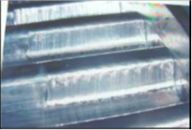| Q1 |
Is it necessary to adjust the alignment of belt sprocket? |
| A1 |
Synchronous belt does not run in the center of belt sprocket even if the belt sprocket is aligned correctly, and has property of shifting to either side.
Although its force is very weak, poor alignment of belt sprocket may cause it to travel closer to the edge of belt sprocket and be strongly pressed against the guide flange, resulting in damage and cut.
Also, the guide flange may fall off.
Adjust the alignment of belt sprocket within the allowable range listed below.
| Belt Size |
All |
| Belt width mm |
Up to and incl. 30 |
30~50 |
50~100 |
Over 100 |
| Allowable degree of parallelization |
Up to and incl. 5/1000 |
4/1000 or less |
3/1000 or less |
2/1000 or less |
| θ min |
Up to and incl. 17 |
Up to and incl. 13 |
Up to and incl. 10 |
Up to and incl. 6 |

[Click to enlarge ]
■How to adjust the belt sprocket
As shown in the diagram, apply the straight edge to the end face of the standard belt sprocket. Make the other belt sprocket contact with straight edge on all faces (to make ε=0), so that the belt sprockets can be aligned in the correct position.
Parallelism of shafts can be obtained simultaneously by setting δ in the diagram below the limit.

[Click to enlarge ]
Back to questions
|
| Q2 |
How to install Lock Belt Sprocket? |
| A2 |
- Wipe off any dust from shaft surface and apply a thin coat of oil or grease. (Molybdenum-based anti-friction agents cannot be used.)
- For S type ・・・
Remove the locking bolts, wipe the contact surface between belt sprocket and sleeve clean, and apply oil or grease. Also apply to the thread and seat areas of locking bolts. (Molybdenum-based anti-friction agents cannot be used.)
For S type with plating ・・・
Remove the locking bolts and wipe the contact surface between belt sprocket and sleeve clean.
Do not apply oil or grease because it is not required.
- Lightly tighten the locking bolts to tentatively assemble the sleeve.
- Lightly push Lock Belt Sprockets tentatively assembled in 3) to the specified position by hand.
- Tighten the bolts evenly in diagonal order with 1/4 of the rated tightening torque MA.
- Raise the tightening torque to 1/2 of MA and tighten in the same manner as 5).
- Raise the tightening torque to the rated value and tighten in the same manner as 5) and 6).
Precautions when installing Lock Belt Sprockets
-
A torque wrench must be used to tighten the locking bolts. Be sure to tighten according to the tightening instruction and tightening torque MA. Tightening with a wrench other than a torque wrench or hand-tightening will result in incomplete installation, and lead to accidents such as slipping or deformation.
-
Tightening bolt with a torque higher than the tightening torque may cause bolt damage. Also, tightening below the tightening torque may cause the bolts to loosen, so be sure to tighten with the specified tightening torque MA.
-
Never use bolts other than those provided with this product as tightening bolts. Otherwise, bolts may damage and cause accidents. Contact us if you need a new bolt due to lost or replacement.
Back to questions
|
| Q3 |
How to Install guide flanges? |
| A3 |
■Securing the flange
Clinching
Normally, pressed flanges and turned flanges are secured by clinching using a punch as shown below. The number of places to clinch is as follows.
| Tip Diameter mm |
Up to and incl. 30 |
Over 30, up to and incl. 50 |
Over 50, up to and incl. 120 |
Over 120, up to and incl. 250 |
| Number of places to clinch |
4 |
8 |
12 |
16 |
Notes
- Place a belt sprocket on a flat table and clinch the flange using a punch.
- When clinching a place opposite the hub, inset the hub to a cylindrical fixture placed on the table to ensure it is stable.
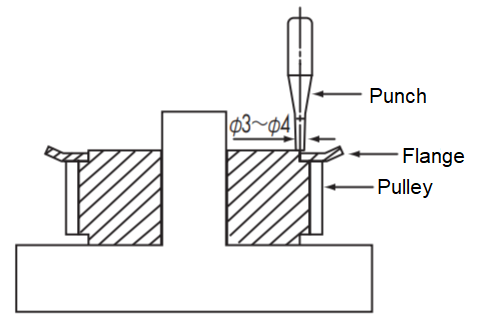 [Click to enlarge ]
Securing with screws
Turned flanges for the large number of teeth of P8M, P14M may be secured to the belt sprocket with countersunk head screws depending on applications. The number of screws shown in the following table is the minimum number.
| Tip Diameter mm |
Up to and incl. 120 |
Over 120, up to and incl. 250 |
Over 250, up to and incl. 450 |
Over 450, up to and incl. 650 |
| Number of screws |
4 |
6 |
8 |
12 |
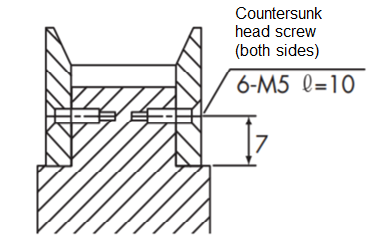 [Click to enlarge ]
Securing by knurling
Another method often used for securing is knurling created with a lathe.
Back to questions
|
| Q4 |
How to select the belt sprocket? (Selection from power) |
| A4 |
- Tentatively select the belt size from the design power and small belt sprocket revolution speed using the simplified selection table described in the Tsubaki Synchronous Belts & Belt Sprockets Catalog.
- Tentatively select the belt width and the number of small belt sprocket teeth in the standard transmission capacity table described in the same catalog. At this time, please note the following.
- Select the number of small belt sprocket teeth other than the colored part of the standard transmission capacity.
- Select the small belt sprocket so that the pitch circle diameter of the small belt sprocket > the belt width.
- Verify that the bore usable range of the small belt sprocket satisfies the shaft diameter to be used.
- Determine the number of teeth of the large belt sprocket based on the number of teeth of the small belt sprocket and the speed ratio. Also, verify the bore diameter to use.
Back to questions
|
| Q5 |
How to select the belt sprocket? (Selection from torque) |
| A5 |
- Tentatively select the belt size from the design torque and small belt sprocket revolution speed using the simplified selection table described in the Tsubaki Synchronous Belts & Belt Sprockets Catalog.
- Tentatively select the belt width and the number of small belt sprocket teeth in the standard transmission torque table described in the same catalog. At this time, please note the following.
- Select the number of small belt sprocket teeth other than the colored part of the standard transmission torque.
- Select the small belt sprocket so that the pitch circle diameter of the small belt sprocket > the belt width.
- Verify that the bore usable range of the small belt sprocket satisfies the shaft diameter to be used.
- Determine the number of teeth of the large belt sprocket based on the number of teeth of the small belt sprocket and the speed ratio. Also, verify the bore diameter to use.
Back to questions
|
| Q6 |
Why more than 6 meshing teeth are required? |
| A6 |
Unlike metallic chains and gears, synchronous belt's teeth are rubber materials covered with nylon fabric, so they are not suitable for transmission with only one tooth, and must be loaded with multiple teeth.
If number of teeth engaged with belt sprocket is less than 6, load per tooth will increase, resulting in tooth chipping. If number of teeth engaged is 5 teeth or 4 teeth, add "meshing correction factor" described in the catalog to select.
For drive belt sprockets, make sure that number of teeth engaged should be 6 or more and engagement angle should be 120 degrees or more.
Back to questions
|
| Q7 |
What is precautions for high-speed rotation with a small belt sprocket? |
| A7 |
Avoid using combinations at the colored part in the transmission capacity table described in the Synchronous Belts & Belt Sprockets Catalog because small diameter belt sprocket rotates at high speed, which promote bending fatigue of synchronous belt cord inside and shortens its life.
Back to questions
|
| Q8 |
What is precaution point when using servo motor? |
| A8 |
When the circumferential speed of synchronous belt is fast, the following phenomena may occur.
- If the speed of belt sprocket exceeds 33m/s, or more, run-out or vibration may occur. Balance the belt sprocket.
- When selecting a synchronous belt, it is recommended to examine the torque in consideration of the characteristics of servo motor.
Back to questions
|
| Q9 |
What is the material of belt sprocket? |
| A9 |
The following materials are suitable for belt sprockets.
Units :g/cm3
| Material |
material symbol |
Unit mass |
| Carbon steel for machine structural use |
S45C |
7.85 |
| Aluminum alloy |
A2017-T4 |
2.8 |
| Stainless Steel |
SUS304 |
7.8 |
Back to questions
|
| Q10 |
What kind of surface treatment is for the belt sprocket? |
| A10 |
Various surface treatments are available according to applications.
| Type of Surface Treatment |
Effect |
Applicable Material |
| Blackening |
Rust prevention, decoration |
Carbon steel |
| Electrogalvanization |
Rust prevention, decoration |
Carbon steel |
| Electroless nickel phosphorus plating |
Rust prevention, decoration |
Carbon steel |
| Alumite |
Rust prevention |
Aluminum alloy |
| Hard alumite |
Rust prevention, wear resistance |
Aluminum alloy |
Back to questions
|
| Q11 |
What is the backlash-less tooth profile? |
| A11 |
For synchronous belt engagement, a backlash is usually provided. However, for synchronous belt drive used for robots, electronic component assembling machines, NC machines, printers, plotters, etc. that require highly accurate rotation, belt sprockets having a special backlash-less tooth profile with minimal backlash to minimize rotating angle errors are also available. Please contact us.
Back to questions
|
| Q12 |
Can special order products other than those listed in the catalog be manufactured? |
| A12 |
Belt Sprockets with dimension, number of teeth, and material other than those listed in the catalogue can also be manufactured. Please contact us.
Back to questions
|
| Q13 |
Which atmosphere temperature can the belt sprocket be used? |
| A13 |
Use the product in normal environment with an operating temperature range of-15℃ to 80℃ (aluminum: 0℃ to 50℃).
Back to questions
|
| Q14 |
Is it compatible with other companies' products? |
| A14 |
Tsubaki belt sprocket for PX belt is original tooth profile and is not compatible with other companies.
Please use it together with Tsubaki synchronous belt.
Back to questions
|
| Q15 |
What should be careful before using? |
| A15 |
Precautions are summarized in the catalog "Synchronous Belts & Belt Sprockets". Be sure to read the "Instruction Manual" pages before use.
Back to questions
|
| Q16 |
What are precautions when installing synchronous belt to belt sprocket? |
| A16 |
Synchronous belt hardly stretches even when force is applied.
Move belt sprocket shaft / idler shaft before installing it on belt sprocket.
Do not attempt to over the guide flange of belt sprocket forcibly, as this may cause an accident.
For 2-shafts transmission without an idler, prepare an adjusting margin of inter-axial distance.
■Adjusting margin of inter-axial distance
Units :mm
|
Belt length |
Types |
P2M・P3M・P5M
UP3M・UP5M |
P8M・P14M
UP8M・UP14M |
| △Co |
Up to and incl. 500 |
3 |
3 |
| 500~1000 |
5 |
5 |
| 1001~2000 |
10 |
10 |
| 2000以上 |
15 |
15 |
| △Ci |
Common |
10 |
15 |
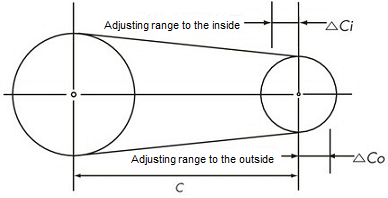 [Click to enlarge ]
Back to questions
|
| Q17 |
What is a precaution with atmosphere when using synchronous belt and belt sprocket? |
| A17 |
Use the synchronous belts in a clean environment.
Protect synchronous belt and belt sprocket by covering it when used in dusty atmosphere where it may be exposed to excessive water, oil or solvents. Please consider "Ultra PX Belt Oil-Proof Type" in an atmosphere with a lot of moisture and oil in the air, and "PX Belt Water-Proof Type" in an atmosphere with a lot of moisture.
For belt sprockets, stainless steel series which is effective for corrosion resistance and chemical resistance, or surface treatment series which is effective for rust prevention may be available. Please consider it.
Back to questions
|
| Q18 |
What kind of noise is there? |
| A18 |
Generally, it is as follows.
- ①Impact noise generated when the bottom of the synchronous belt collides with the top of the belt sprocket.
- ②Synchronous belt string vibration noise
- ③Friction noise generated when the tooth of synchronous belt engage with the tooth groove of belt sprocket while rubbing against each other
- ④Friction noise generated when the side face of synchronous belt and the guide flange of belt sprocket rub against each other
- ⑤Air discharge noise generated by discharging air from the tooth groove of belt sprocket when synchronous belt and belt sprocket are engaged
Back to questions
|
| Q19 |
What are measures against noise? |
| A19 |
- ①Change natural frequency of synchronous belt by changing installation tension, belt sprocket revolution speeds, belt length, belt width, number of belt sprocket teeth, etc.
- ②Change to a high strength synchronous belt and narrows belt width
- ③Narrows belt width and change to multi-strand
- ④Adjust the alignment of belt sprocket so that synchronous belt does not touch guide flange.
Back to questions
|
| Q20 |
Does it comply with RoHS Directive? |
| A20 |
Compliant with RoHS Directive.
Back to questions
|
| Q21 |
What about the price and delivery of synchronous belt and belt sprocket? |
| A21 |
All of our products are sold through distributors, so please contact them.
Back to questions
|
| Q22 |
If the belt sprocket outer diameter is too small, what will affect the belt? |
| A22 |
There is a risk of premature breakage of synchronous belt.
[Appearance features ]
Breakage is parallel to the belt teeth. The cords are also short and cut.
[Possible causes ]
- ①The cords were broken due to excessive bending during storage and assembly.
- ②The cords were broken because the belt sprocket diameter was too small.
[Action ]
- ①Be careful when storing and assembling, and do not bend it excessively. Do not bend to a diameter less than 4 times the pitch.
- ②Check if diameter of belt sprocket and idler is appropriate, and change it to the appropriate diameter if it is too small. Check the belt sprocket diameter in the transmission capacity table, and the idler diameter in the table below.
■Idler is used in the following cases.
- The bearing is stationary and an idler is used for adjustment of the installation tension.
- The speed ratio is large and the number of meshing teeth of the small belt sprocket needs to be increased.
- No belt guide can be used on the drive and driven belt sprockets.
■Precautions for using the idler
- The idler must be stationary and as a rule be used on the slack side
- Note that if the parallelism between the axis of the idler and the axes of both belt sprockets is poor, the idler may cause the belt to disengage from the belt sprockets
- Determine the idler diameter according to the following criteria.
- Inside idler ......A timing belt sprocket having the number of teeth greater than the minimum number of teeth of belt sprocket in the following table.
- Outside idler ......A flat belt sprocket that is greater than 1.2 times the pitch circle diameter of the belt sprocket in the following table and does not have a crown.
■Minimum number of teeth of belt sprocket for selection of an idler
| Types |
Speed r/min |
| Up to and incl. 900 |
Over 900, up to and incl. 1200 |
Over 1200, up to and incl. 1800 |
Over 1800, up to Type and incl. 3600 |
| P2M |
16 |
16 |
18 |
20 |
| P3M・UP3M |
14 |
14 |
16 |
18 |
| P5M・UP5M |
18 |
20 |
24 |
28 |
| P8M・UP8M |
24 |
26 |
26 |
28 |
| P14M・UP14M |
28 |
28 |
28 |
34 |
Note) For revolutions above 3600 r/min, refer to the Standard Transmission Capacity Table.

Inside idler

Outside idler
There is a risk of crack on rubber on back of synchronous belt.
[Appearance features ]
- There are cracks on the back of synchronous belt parallel to the teeth.
[Possible causes ]
- ①Belt sprocket or idler diameter being used is too small.
- ②Operating atmosphere temperature is too high or too low.
- ①Check if diameter of belt sprocket and idler is appropriate, and change it to the appropriate diameter if it is too small.
(Check the belt sprocket diameter in the transmission capacity table, and the idler diameter in the table below. )
■Idler is used in the following cases.
- The bearing is stationary and an idler is used for adjustment of the installation tension.
- The speed ratio is large and the number of meshing teeth of the small belt sprocket needs to be increased.
- No belt guide can be used on the drive and driven belt sprockets.
■Precautions for using the idler
- The idler must be stationary and as a rule be used on the slack side
- Note that if the parallelism between the axis of the idler and the axes of both belt sprockets is poor, the idler may cause the belt to disengage from the belt sprockets
- Determine the idler diameter according to the following criteria.
- Inside idler ......A timing belt sprocket having the number of teeth greater than the minimum number of teeth of belt sprocket in the following table.
- Outside idler ......A flat belt sprocket that is greater than 1.2 times the pitch circle diameter of the belt sprocket in the following table and does not have a crown.
■Minimum number of teeth of belt sprocket for selection of an idler
| Types |
Speed r/min |
| Up to and incl. 900 |
Over 900, up to and incl. 1200 |
Over 1200, up to and incl. 1800 |
Over 1800, up to Type and incl. 3600 |
| P2M |
16 |
16 |
18 |
20 |
| P3M・UP3M |
14 |
14 |
16 |
18 |
| P5M・UP5M |
18 |
20 |
24 |
28 |
| P8M・UP8M |
24 |
26 |
26 |
28 |
| P14M・UP14M |
28 |
28 |
28 |
34 |
Note) For revolutions above 3600 r/min, refer to the Standard Transmission Capacity Table.

Inside idler

Outside idler
- ②Improve the atmospheric temperature to -15℃ to 80℃ where the synchronous belt can be used.
Back to questions
|
| Q23 |
How about wear on the teeth of belt sprocket? |
| A23 |
[Appearance features ]
- Area where synchronous belt is engaged is worn, and there is a step between area not engaged.
- Tooth surface is rough.
[Possible causes ]
- ①Inappropriate belt sprocket material.
- ②In a dusty atmosphere, synchronous belts and belt sprockets were used with abrasive dust adhering on them.
- ③Installation tension of synchronous belt is too high.
[Action ]
- ①Change to a harder material, apply tooth surface hardening or surface treatment to improve wear resistance.
- ②Improve usage atmosphere or install a cover to prevent dust from adhering.
- ③Adjust to the proper installation tension.
Back to questions
|
| Q24 |
How do worn teeth on the belt sprocket affect the belt? |
| A24 |
[Appearance features ]
- Tooth fabric is fluffy, whitish and discolored, and texture is unclear.
- Tooth fabric is worn out and rubber is exposed.
- Belt teeth become thinner.
- Tooth fabric on the bottom of belt tooth is worn out and cord is exposed.
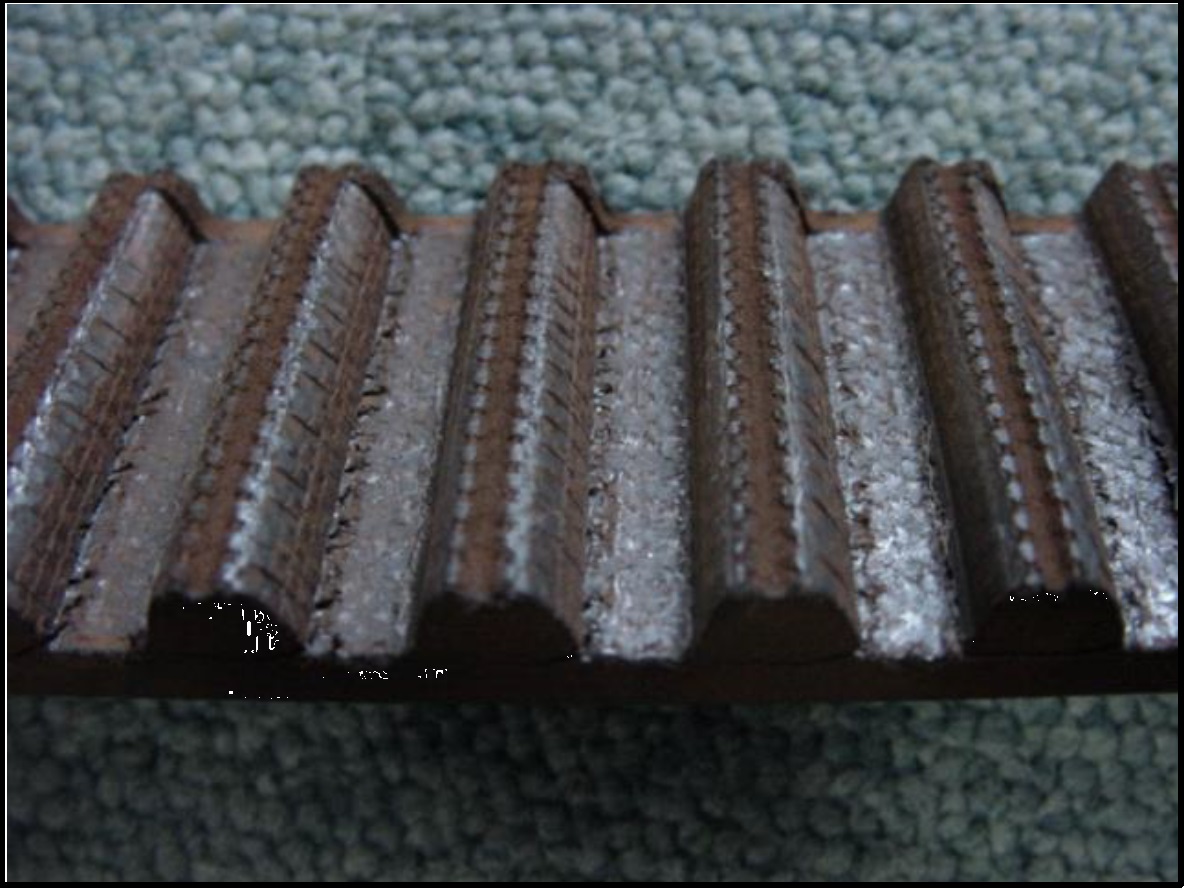
[Click to enlarge ]
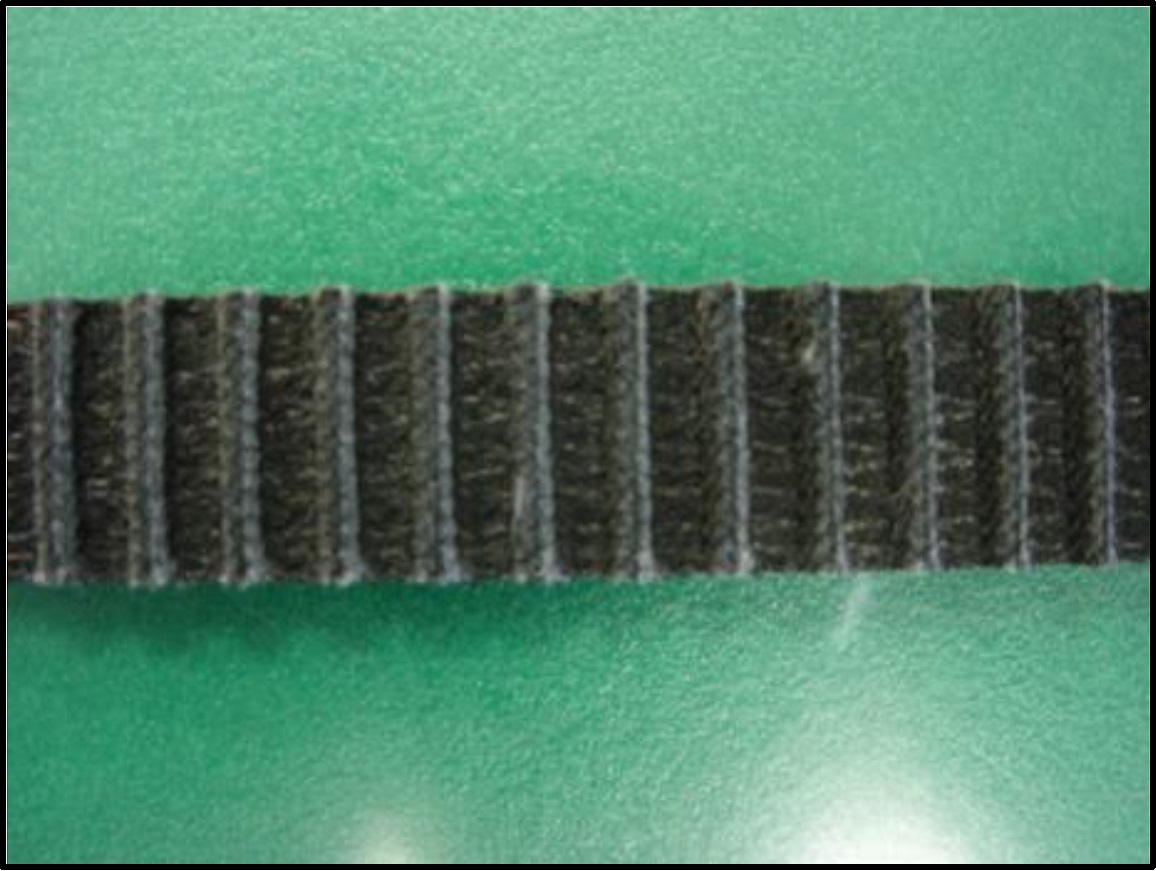
[Click to enlarge ]
[Possible causes ]
- ① Overloaded.
- ② Too high installation tension.
- ③ Insufficient installation tension.
- ④ Insufficient synchronous belt capacity.
- ⑤ Incorrect belt sprocket tooth profile or incorrect dimensions of the tooth part.
- ⑥ Use in dusty atmosphere.
[Action ]
- ① Check motor specifications, inertia of driven unit, and operation conditions to eliminate the cause of overload, or increase the size of synchronous belt / belt sprocket.
- ② ③ Adjust to the proper installation tension.
- ④ Check the operation conditions and select the optimum size synchronous belt / belt sprocket.
- ⑤ Replace with a belt sprocket of the correct tooth profile and dimensions.
- ⑥ Prevent dust from adhering to synchronous belt and belt sprocket by improving atmosphere and installing a cover.
Back to questions
|
| Q25 |
What is the effect on the belt if the number of teeth that engage with the synchronous belt is small? |
| A25 |
There is a risk of tooth jumping of the synchronous belt.
[Possible causes ]
- ① Overloaded (shock load).
- ② Insufficient installation tension.
- ③ Insufficient number of meshed teeth with the belt sprocket.
- ④ Insufficient rigidity of frame.
[Action ]
- ① Eliminate the cause of shock load or install a shock damping mechanism. Or increase the size of the synchronous belt.
- ② Adjust to the proper installation tension.
- ③ Either increase the number of belt sprocket teeth or increase the number of meshed teeth by using an idler.
- ④ Increase the rigidity of frame.
Back to questions
|
| Q26 |
What is the effect on the belt due to poor belt sprocket alignment and deformation of the guide flange? |
| A26 |
Tear and wear of synchronous belt side face
[Appearance features ]
- The corners on the side faces are rounded.
- The rubber on the side face is in a state of being peeled off.
- The cord is frayed and exposed.
[Possible causes ]
- ①Poor parallelism between shafts.
- ②Poor belt sprocket alignment.
- ③Insufficient rigidity of frame.
- ④Deformation of the guide flange of belt sprocket.
[Action ]
- ①Align the parallelism of shafts correctly.
- ②Align the belt sprocket to the correct position.
■Alignment of belt sprocket
Synchronous belt does not turn at belt sprocket center even when belt sprocket-alignment is exact, and it is liable to deviate on either side.
That force is very weak but when belt sprocket alignment is poor, belt-side may be damaged. In extreme cases, it may run on the guide flange and break.
Accordingly, adjust the alignment of belt sprocket within the allowable range listed below.
■Allowable range of belt sprocket alignment
| Belt Size |
All |
| Belt width mm |
Up to and incl. 30 |
30~50 |
50~100 |
Over 100 |
| Allowable degree of parallelization |
Up to and incl. 5/1000 |
4/1000 or less |
3/1000 or less |
2/1000 or less |
| θ min |
Up to and incl. 17 |
Up to and incl. 13 |
Up to and incl. 10 |
Up to and incl. 6 |

[Click to enlarge ]
■How to adjust the belt sprocket
As shown in the diagram, apply the straight edge to the end face of the standard belt sprocket. Make the other belt sprocket contact with straight edge on all faces (to make ε=0), so that the belt sprockets can be aligned in the correct position.
Parallelism of shafts can be obtained simultaneously by setting δ in the diagram below the limit.

[Click to enlarge ]
- ③Increase the rigidity of frame.
- ④Replace with a new one.
Back to questions
|






